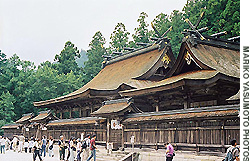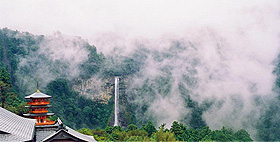Calls for change as WHS status threatens one of Japan's gems
By MARIKO YASUMOTO, Special to The Japan Times, Feb. 6, 2005
Tokyo, Japan -- The breathtaking mountain landscape of the Kii Peninsula, and its ancient temples, monasteries and shrines have captivated the Japanese people for more than 1,000 years.
 << Kumano Hongu Taisha shrine in Wakayama Prefecture is one of three shrines that lie on a popular secton of an age-old pilgrimage route called Kumano Kodo.
<< Kumano Hongu Taisha shrine in Wakayama Prefecture is one of three shrines that lie on a popular secton of an age-old pilgrimage route called Kumano Kodo.
In July last year, the region was brought to the attention of the outside world too, when three holy sites in the Kii Mountains straddling Wakayama, Mie and Nara prefectures, and the age-old pilgrimage route linking them, were designated by UNESCO as World Heritage Sites.
For residents of that remote corner of western Honshu, the announcement covering the Koyasan and Yoshino-Omine uplands, the Kumano Sanzan (three shrines in the Kumano area), and the Kumano Kodo route that links them came like manna from heaven -- a huge boost for tourism in the offing for a part of the world whose economy is sorely in need of a fillip.
Indeed, in the first year following bestowal of WHS status, regional governments are predicting that as much 37.3 billion yen will be pumped into their economies.
However, many scholars and historians fear that putting such emphasis on tourism runs counter to the spirit of the World Heritage Convention, and warn of the often conflicting goals of encouraging more visitors and preserving the heritage that brings them there.
In the front line of this dilemma are local guides, who are devoted both to building ties between visitors and residents and protecting the environment.
One such guide is Isao Sakamoto, who, one unusually warm day recently, took me along the Nakahechi, a popular section of the Kumano Kodo, which connects the three Kumano Sanzan shrines of Hongu, Hayatama and Nachi.
Sweet-scented air
After a few kilometers, when a lovely zephyr of sweet-scented air from the dense forests breezed across our faces, Sakamoto said: "Ah, this must be the wind from gokuraku (paradise)."
 The sacred Nachi no Taki (Nachi >>
The sacred Nachi no Taki (Nachi >>
Falls) and Seigantoji Temple with its three-story pagoda are both to be found on the Kumano Kodo pilgrimage trail in Wakayama Prefecture.
Sakamoto is the head of a volunteer guide group in Hongu Town, eastern Wakayama Prefecture, and his friendly smile, devotion to nature and deep knowledge of Kumano Kodo history make him a charismatic and respected figure. Since WHS status was conveyed on his beloved home, this 76-year-old former junior high school teacher of local history is delighted to be meeting people from around the world. There are, though, some things that sadden him. In particular, Sakamoto said, he is always picking up trash along the Nakahechi, and sees many flowers thoughtlessly crunched under tourists' boots. "I really don't want to see these things happening," he sighed.
In fact, according to surveys, those things don't happen when visitors are able to interact with locals or guides, but are far more likely to occur when they just arrive and head off on their own.
"By getting in touch with local people, tourists deepen their understanding of the region and have the same awareness of the environmental problems," said Hiroshi Maeda, an associate professor in Hannan University's department of international tourism.
Altogether, in the Kii Mountains area, there are more than 800 local guides, most of them volunteers. Though that may sound like a lot, most are part-timers and their availability is limited. To enlist Sakamoto as a guide, for example, would mean booking him around two months in advance.
To address this problem, the area's local governments are stepping up efforts to recruit more guides with regular workshops. Meanwhile, some guide groups are urging the introduction of charges for their services, to encourage young people to take up guiding as a career.
"Looking ahead, local guides should be recognized as professionals," said Masao Yamakawa, a guide coordinator of the Higashi-Kishu Regional Tourism Association in Mie Prefecture.
When it comes to interpreter-guides, things get even more complicated. Unlike most other World Heritage Sites, one of the chief attractions of the Kii Mountains are the customs and legends of the area that have been handed down from time immemorial. Consequently, foreigners may be able to understand very little of what they see unless information is available in their languages.
Eternal meditation
One such visitor I met along the way was Cousin Isaac, a San Francisco musician temporarily living in Hashimoto City, Wakayama Prefecture, who said he had visited Koyasan several times with his wife. Of course, they were fascinated by the beautiful temples and enjoyed shojinryori vegetarian meals -- but it wasn't until a local interpreter-guide volunteer went out with them that he said their eyes were really opened to what they were seeing.
"Before our tour [with the guide], we had no idea what anything meant, no clue as to the history," Isaac said. "Such is the richness of information that you won't find it in 'Lonely Planet.' "
Isaac was particularly fascinated by tales of Koyasan's Okunoin. This is the cemetery where Kobo Daishi (Kukai), the founder of the Shingon School of Esoteric Buddhism who chose Koyasan as its headquarters, rests in eternal mediation amid some 300,000 tombstones, each with a tale to be told.
Leading Isaac on his tour was Kaori Kodama, head of the 30-strong Wakayama Interpreter Volunteer Group. The organization offers services in several languages, including English, Portuguese, Spanish, German, Malay and Korean, and combined with its members' profound knowledge of the region's history, it is probably unique in what it can offer foreign visitors.
Despite the best efforts of Kodama and her team, there remains a woeful shortage of interpreter-guides in this idyllic area. Blame lies, at least in part, with central government, which insists on people passing an extremely difficult national license exam and prohibits unlicensed interpreter-guides from receiving fees.
As a result, unless they pass that exam -- which requires extensive, Japan-wide knowledge, and has a pass rate of just 5 percent -- interpreter-guides have no choice but to remain volunteers.
In addition, licensed interpreter-guides usually move to metropolitan areas, where there is often the chance to make more money.
"However, if our activity is limited to volunteer work, this WIVG organization will dwindle away," said Kodama, who teaches at an English conversation school at night. "I really wish our 10-year experience was more highly valued."
Taking this situation seriously -- especially since the WHS designation -- the Wakayama Prefecture authorities called on central government to designate such areas as "Special Tourism Zones" in which unlicensed guides are allowed to charge for their interpretation services.
However, bureaucrats in the Ministry of Land, Infrastructure and Transport turned the proposal down -- but it did prompt them to take one small step forward. After having received similar requests from several other prefectures, including Hokkaido (where WHS designation is currently being sought), Yukio Miyata, an official with the Wakayama preferectural government's tourism department, said that the question of whether to limit the scope of the exam to the region where an examinee plans to work as a guide is now being considered by a Diet committee.
It can only be hoped that the priceless resource of well-informed local guides -- whether Japanese-speaking or multilingual -- will be fostered in practical terms from on high, not least for their vital role in the preservation of natural treasures such as the Kii Mountains.

 << Kumano Hongu Taisha shrine in Wakayama Prefecture is one of three shrines that lie on a popular secton of an age-old pilgrimage route called Kumano Kodo.
<< Kumano Hongu Taisha shrine in Wakayama Prefecture is one of three shrines that lie on a popular secton of an age-old pilgrimage route called Kumano Kodo. The sacred Nachi no Taki (Nachi >>
The sacred Nachi no Taki (Nachi >>